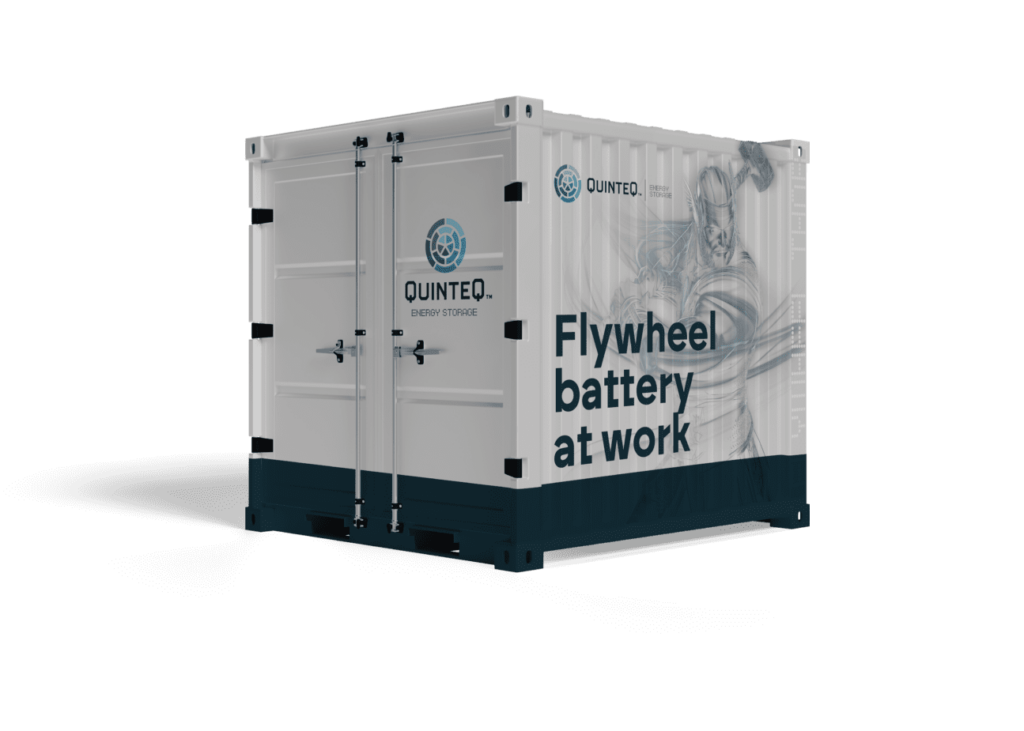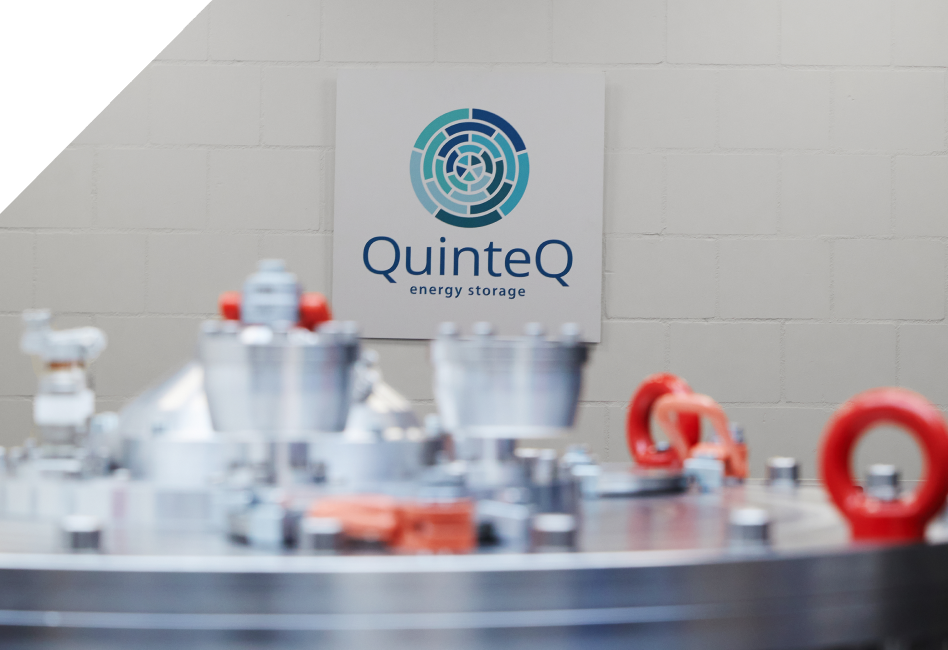We’re proud to share this article by Gordon Feller for PowerMag, featuring QuinteQ’s role in the electrification of the Port of Rotterdam using its flywheel energy storage technology. Have a read below, or read the original article here.
Flywheel Energy Storage Technology
Transforms Port Operations
The Port of Rotterdam (PoR) is working to future-proof operations, aiming to be a CO2 neutral port in 2050. These ambitions align with plans made by port tenants, such as Rhenus Logistics. They, and other companies like them, are committed to achieving net-zero emissions by transitioning to an all-electric port operation. New technologies and innovations are playing a role in achieving this goal.
One of the companies involved in the PoR’s push is the Dutch-based firm QuinteQ Energy B.V. With help from PoR, QuinteQ has worked with Rhenus Logistics, successfully completing a pilot and demonstration project focused on a sustainable energy storage solution for the port industry. QuinteQ developed a containerized flywheel energy storage system (Figure 1) that reduces peak power demand of electric cranes by up to 65%. The demonstration concluded in April 2024 at the Rhenus Waalhaven Terminal in Rotterdam.

1. QuinteQ’s flywheel is safe, compact, and can be placed in a regular shipping container. A single flywheel module is able to deliver 300 kW and 5 kWh.
QuinteQ’s unique flywheel technology originated from Boeing’s research for a U.S. government laser-based space defense program. Boeing developed and tested four prototypes, proving the technology’s potential for high-power systems in space applications. After the program’s cancellation, QuinteQ obtained an exclusive worldwide intellectual property (IP) license and adapted the technology for application on Earth. According to QuinteQ’s CEO and co-founder Paul Vosbeek, “Since acquiring the technology from Boeing’s R&D [research and development] lab, we have focused on reducing complexity while maintaining its innovative, high-tech competitive advantage. Now, six years later, we have begun manufacturing the rugged, proven product at our factory in Culemborg.”
Among its target markets, QuinteQ prioritizes port electrification. The flywheel is specifically designed to manage peak power demands from crane operations. In the Port of Rotterdam, this innovative solution helps regulate short, high-frequency power peaks caused by lifting heavy loads.
“Port cranes require significant power for short periods during lifting. When idle, their power consumption drops to zero, creating extreme fluctuations that demand a robust power supply,” explained Timo Pauel, business development manager for QuinteQ. “The QuinteQ flywheel mitigates these power peaks, reducing strain on the electrical grid. This enables more efficient energy use and allows ports to expand their electrical capacity without expensive and time-consuming grid upgrades.”
The Netherlands is experiencing a nationwide challenge known as “grid congestion,” where the rapid electrification of industries, such as electric vehicle (EV) charging, renewable energy, and electric heating, has outpaced the grid operator’s capacity. Contracting higher power connections takes years, creating a growing demand for battery storage solutions such as QuinteQ’s flywheel battery.
According to Corinna Insel, sustainability manager at Rhenus Logistics, the flywheel frees up power capacity for other purposes. “The energy transition presents significant challenges. We are uncertain about the future of electrification and whether there will be sufficient grid power available.”
The transition to fully electrified port operations requires significant modifications to PoR’s existing energy infrastructure. However, challenges also present opportunities for innovation and collaboration. In partnership with Rhenus, QuinteQ conducted a research and demonstration project (Figure 2) that revealed the flywheel can free up 65% of grid capacity by regulating the peak load of port cranes. This solution not only addresses immediate electrification needs but also strengthens the resilience of the maritime sector.

2. A pilot project at the Port of Rotterdam demonstrated how QuinteQ’s flywheel technology effectively manages and mitigates power peaks caused by crane operation, reducing the load on the electrical grid.
A three-week pilot demonstrated the system’s ability to support a terminal’s main power distribution, supplying energy to three operational port cranes. During periods of low power consumption, the flywheel charges. When high power demand is detected (hoisting operations), it discharges, supplementing the terminal’s power supply (Figure 3). QuinteQ continuously performed measurements and the flywheel prototype responded adequately to the power peak demand of the port cranes. A permanent installation of a QuinteQ system provides Rhenus Logistics with close to 400 kW of power that can be repurposed without the need for grid upgrades.

3. A real-life data trace and graphic representation of the achieved power reduction on the terminal.
Electrifying port assets introduces surges in energy demand and volatile power peaks, particularly in legacy sites still structured around fossil fuel energy. As ports shift toward a fossil-free system, they face increasing constraints due to grid congestion and the difficulty of upgrading infrastructure. This necessitates innovative energy solutions. QuinteQ’s flywheel is a crucial component in transforming ports into energy hubs.
The successful pilot project marks a significant step toward integrating sustainable energy solutions into port operations. Rhenus Logistics and QuinteQ are eager to further develop and expand their collaboration, accelerating the transition to a more sustainable future. An important footnote here is that the specifics can be different for each location. When there are more cranes, or cranes with a larger installed capacity, the flywheel configuration and power savings may be different. It is therefore important to always perform a measurement and analysis first, QuinteQ can support in that effort. QuinteQ’s system is configurable in power and capacity to ensure an optimal product-solution fit.
The global shift toward decentralized energy generation (solar and wind) has accelerated the adoption of energy storage solutions. While battery energy storage systems (BESS) are prevalent, QuinteQ’s mechanical battery stands out because of the independence of electrochemical cells (such as lithium-ion). Unlike traditional batteries, the flywheel eliminates the risk of thermal runaway, making it a safer option for port operations. Additionally, its components are widely available, reducing reliance on geopolitically sensitive supply chains. The containerized design ensures flexibility and rapid deployment and decommissioning. As port tenants can circulate, the terminal’s power demand can shift every few years. The containerized flywheel system with its small footprint can be repurposed flexibly.
The partnership between PoR, Rhenus Logistics, and QuinteQ underscores the importance of innovative energy storage solutions in achieving sustainable port operations. The successful completion of this pilot paves the way for broader adoption of peak-shaving flywheel technology in maritime infrastructure worldwide.
—Gordon Feller (Gordon.Feller@gmail.com) has served as a consultant/advisor to numerous private companies, government agencies, and trade associations since 1983. He also serves as a global fellow at the Smithsonian Institution and at the Woodrow Wilson International Center for Scholars.


